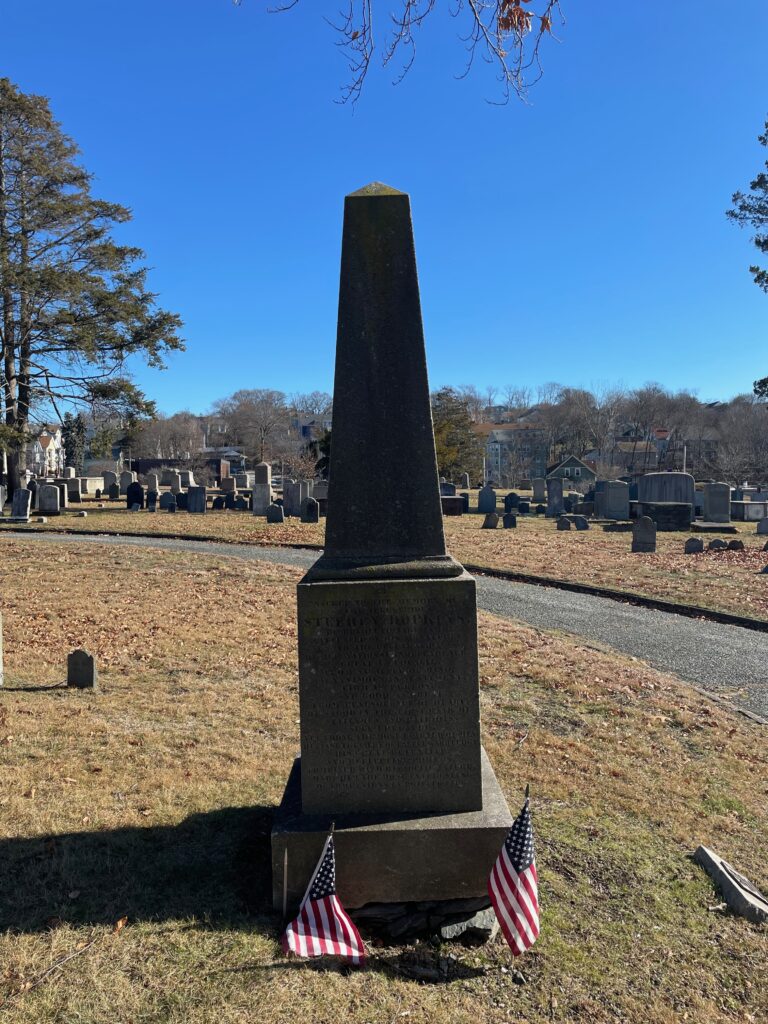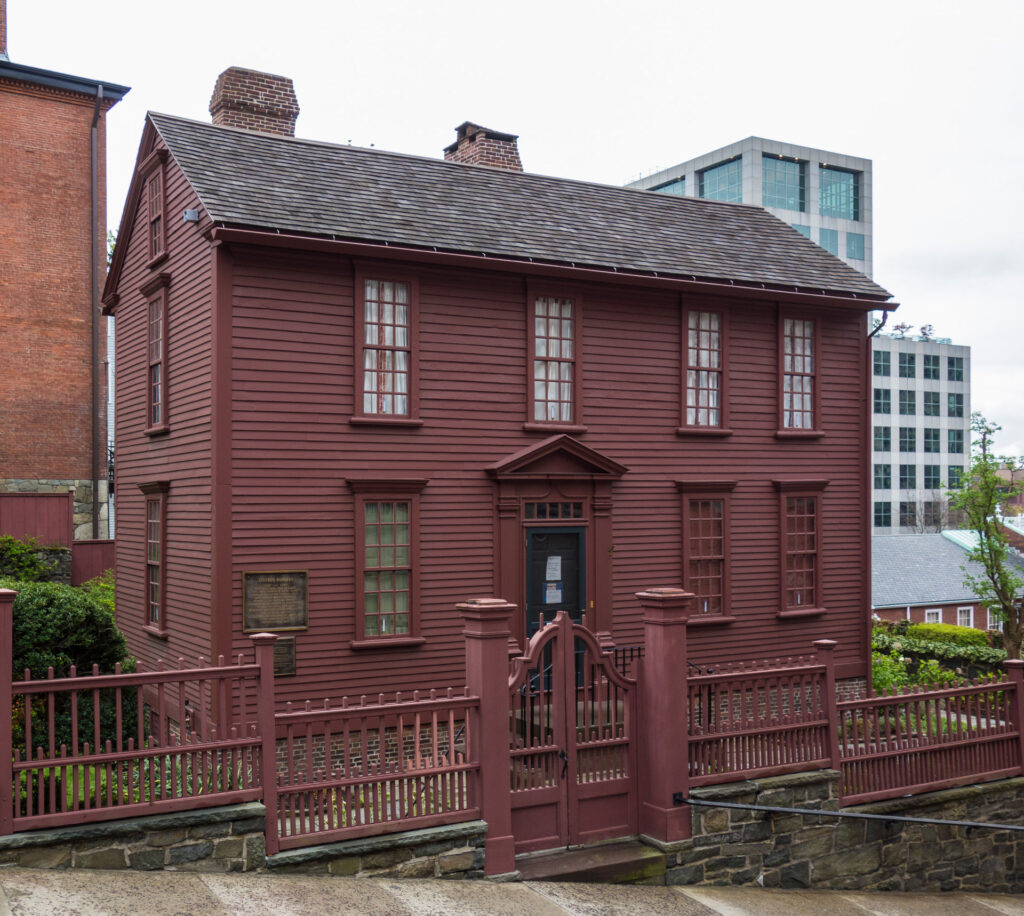Erik Visits an American Grave, Part 1,295
This is the grave of Stephen Hopkins.

Born in 1707 in Providence, Rhode Island, Hopkins was part of the elite of that colony. His family had settled there early and had played leading roles in it from the Roger Williams days. They lived in what later became Scituate, a town that means nothing to you if you don’t live in Rhode Island and also means nothing to do you if you do live in Rhode Island. The young Hopkins was deeply interested in science, or what passed for it in early 18th century Rhode Island. He was interested in this all the way through the rest of life, which included the arrival of the Enlightenment to American shores, which he embraced.
Hopkins became involved in politics at a young age. In 1730, he became justice of the peace in Scituate and rose up the local legal and political world, mostly at the town rather than the colony level, but still, he was a known figure in Rhode Island life. He was in the House of Deputies at times and sometimes was the Speaker. He moved to Providence in 1742 to be where the action was, both politically and for his business interests. By the 1750s was probably the most important political person in the colony. He became governor for the first time in 1755, serving on and off in the position, usually for short terms, until a fourth stint ended in 1768. In between some of those spells, as well as before, he was on the state Supreme Court, starting in 1751. The reason Hopkins’ period as governor ended in 1768 is that he and his rival Samuel Ward bitterly hated each other and it was over the very real issue of currency. Hopkins was a paper currency guy and Ward was a hard currency guy and they hated each so much that it paralyzed the colony’s politics. They came to an agreement in 1768 that neither of them would run again and indeed they did not. This whole deal is a bit more interesting than it might sound–Ward represented the Newport interests that were already older and more conservative, whereas Hopkins represented Providence interests that were more liberal politically and more risk-taking in business, precursors to the Industrial Revolution that would explode in Rhode Island a few decades later.
Hopkins had significant business interests, running a foundry. He was also a merchant, including in the slave trade. That meant some travel. Like a lot of rich Rhode Island merchants, he traveled to Suriname. While there once, a bunch of them commissioned an artist named John Greenwood to paint a picture of them partying. While Hopkins was not unlucky enough to be the guy portrayed as puking, he is the guy portrayed as pouring the punch bowl over another dude’s head. Here it is:

Fun times for slaving merchants!
Of course Hopkins was a slave owner himself, probably owning about seven. By Virginia standards, that wasn’t much, but by Rhode Island standards, where most slave owners owned one, it was a lot. Again, the wealth in Rhode Island is very much connected to the legacy of slavery, lest people here think that somehow slavery and racism is a southern problem and not something, let’s say, connected to the choices people make on where to send their kids to school in all parts of the nation.
As the American Revolution began, Hopkins was on the side of the Patriots. In fact, he had long advocated for colonial rights. At the very beginning of the colonial agitation over the post-Seven Years War taxes, in 1764, he wrote a pamphlet entitled The Rights of Colonies Examined, which laid out the case for colonial rights and made Hopkins a leader in the Patriot movement across the North American colonies. He was Chief Justice of the Supreme Court in 1772 during the Gaspee incident, which again, was the trashy version of the Boston Tea Party, when a bunch of Rhode Island yahoos came out and burned a British ship stuck on the shoals of Narragansett Bay. So he had to deal with the litigation around that. Then, in 1774, he was named one of Rhode Island’s two representatives of the First Continental Congress. He and Ward still hated each other, but Ward was the other one. They may have disagreed about currency reform, but they did agree about the status of the colonies vis-a-vis the British.
By the time of the Declaration of Independence in 1776, which Hopkins very much supported, he was old and his health was starting to fail. To sign the document, he had to steady his writing hand with his other hand to combat the palsy afflicting him. But sign it with pride he did. He also worked on naval armament issues in the Congress, which made sense given his significant experience with the Atlantic World, much more so than most of the delegates. He stayed in the Continental Congress until late 1776, when he resigned and went home to rest. He wasn’t too involved in his foundry’s works at this point and his son ran it, but he co-owned it with Moses Brown among others and it was an important manufacturer for ammunition in the Revolution. He actually lingered for a long time, and died only in 1785, at the age of 78. Toward the end of his life, Hopkins was evicted from the Quaker church due to his refusal to free his slaves.
Hopkins’ house in Providence still stands and it’s a great example of a mercantilist class house from that time.

Stephen Hopkins is buried in North Burial Ground, Providence, Rhode Island.
If you would like this series to visit other signers of the Declaration of Independence, you can donate to cover the required expenses here. I do hate to bring this up, but in the last month, I have received precisely $0 in donations for this series, despite mentioning it on every post. If you want it to continue for very much longer, as I wind through my last remaining grave photos, you really do have to help out here This is a fully crowd-funded series. There is nothing like this series anywhere on the internet or in the history of the internet. This is 100% unique content you are getting, but it does cost some money. So if you want this series to be more than just the occasional Rhode Islander in the near future, I really want to encourage you to contribute to the fund. John Witherspoon is in Princeton, New Jersey and Benjamin Harrison is in Charles City, Virginia. Previous posts in this series are archived here.


